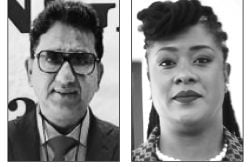For the ordinary Guyanese it must have been something of a mystery as to why President Irfaan Ali should agree to meet with a man who has ‘annexed’ three-fifths of our territory, has been making moves which suggested a preparedness to invade and then had the effrontery to accuse the Guyana government of aggressive rhetoric and behaviour. As was said in our editorial on Monday, there were many things about the meeting in St Vincent on Thursday which were “problematic”, including that it rewarded President Nicolás Maduro for his “flagrant aggression” towards this country. Exactly what, citizens must have been asking, did Guyana have to gain from a face-to-face encounter between the two leaders?
Despite the fact there was little cause for optimism about such a rendezvous, it has to be conceded that President Ali would have had little choice about putting in an appearance at St Vincent’s Argyle Airport; the diplomatic pressure was too great. Everyone from Brazilian President Lula, to Caricom to CELAC was beating the same drum, and this was not an international clamour that our head of state could have easily resisted without appearing perverse. Why the regional heavyweights should have decided that the threat to peace in the region had not been generated by Venezuela alone, but by the two states together probably varied from one to the next, but whatever the reason their insistence was sufficient to corner our head of state into agreeing to meet his Caracas counterpart.
As it was the meeting itself turned out to be a very crowded affair with Caricom heavily represented in addition to the facilitator, St Vincent PM and CELAC pro tempore President Ralph Gonsalves. There too were PMs Roosevelt Skerrit of Dominica, Philip Davis of The Bahamas, Mia Mottley of Barbados, Dickon Mitchell of Grenada, Philip Pierre of St Lucia, Terrence Drew of St Kitts and Keith Rowley of Trinidad. This was in addition to President Lula’s chief foreign policy advisor, Celso Amorim, who acted as interlocutor along with Messrs Gonsalves and Skerrit. There were also observers in the form of two representatives of the UN Secretary General, as well as the Foreign Minister of Colombia and the Vice-Minister of Foreign Affairs of Honduras.
One advantage of such a throng of leaders and diplomats around the negotiating table was that it enabled a diffusion of hostility, and allowed for the deflection of untoward remarks within the context of the larger gathering. The groups met each of the two heads separately first to get a grip on the parameters of the potential discussion, and then the two heads came together, again as indicated, in the presence of all the attendees. It was Trinidadian Foreign Minister Amery Browne who gave the most useful account of what transpired.
As reported by the Trinidad Express Dr Browne admitted that the initial interaction between Messrs Ali and Maduro was “somewhat frosty” and there were “some sharp exchanges”. Then there was an exchange informed by the Caricom heads who intervened, asked questions and made suggestions. This produced an interactive discussion which allowed the mood of the room to lighten somewhat, and by the end “there was more warmth, a genuine exchange and several handshakes …” Significantly too, you could see “some progress”, he said.
While it might have been feared in Georgetown that the meeting could have ended in a car crash, a communiqué did emerge at the end of it. First and foremost, the two countries agreed not to threaten or use force against each other in any circumstances, including those consequential to any existing controversies. Furthermore, any controversies between the two states were to be resolved according to international law, including the Geneva Agreement, while they both committed themselves to the pursuance of good neighbourliness, peaceful coexistence, and the unity of Latin America and the Caribbean. In addition it was agreed to continue dialogue on any other pending matters of mutual importance to the two countries.
A problematic area concerned the role of the ICJ, to which Guyana is committed in terms of a route to a resolution of the controversy, but which Venezuela rejects. A compromise on this was arrived at by wording which reflected both positions, namely: “Noted Guyana’s assertion that it is committed to the process and procedures of the International Court of Justice for the resolution of the border controversy. Noted Venezuela’s assertion of its lack of consent and lack of recognition of the International Court of Justice and its jurisdiction in the border controversy.” Both states agreed to meet in Brazil within the next three months or at another time to consider any matter with implications “for the territory in dispute …”
There have been criticisms of the Argyle Declaration, most notably from Opposition Leader Aubrey Norton, who adverted to the wording “for the territory in dispute” in the final clause. There is some justification for this complaint, more especially since “controversies” is the term used earlier in the document. Why the final form was allowed to pass has not been clarified.
So what did Guyana get out of Argyle, if anything? It was Dr Browne again who said “There is [now] a sense of relief, a reduction in fear.” Guyana, he explained, had brought into the room “this sense of an impending crisis or military conflict or invasion that people in the Essequibo or other parts of the country and even the region were beginning to experience,” and the joint declaration had addressed that. It might be asked not so much why Venezuela agreed not to threaten or use force (Guyana did too, but then she is not threatening anyone), but whether it will abide by the requirement. Dr Browne was asked this, and responded, “We are not in control of what any president does outside of the process. But those potentials were discussed very frankly and the tendencies, the domestic factors and pressures were also discussed. And so if there is any departure, especially in the language, et cetera, in the days and weeks, that would be done with full knowledge that the region is aware of what was committed to and is observing behaviour and action and language moving forward.”
And what about Venezuela? Why should it accede to the provision disallowing the use of force? The answer is that this represents a face-saver. Having locked himself in a corner where the logic of his situation might have obliged him eventually to move into the Cuyuni, for example, and those areas of Guyana which can be reached by river from there, President Maduro can now cite Argyle and international commitments as an excuse not to pursue this line of action. He had falsely claimed before going to St Vincent that his Guyanese counterpart was meeting him face-to-face about the controversy as he had been demanding, so now that under the Declaration the two will be meeting again, he will feel a sense of victory.
And then there is that other oft-cited canard of which the Venezuelans are so fond, and in relation to which Argyle provided them with another false triumph. It was given expression by Última Noticias columnist Angel González, who wrote: “They agreed that any dispute between the two States will be resolved in accordance with international law, including the Geneva Agreement of February 17, 1966.
That is, my people, we can say that Guyana formally recognizes the Geneva Agreement, which is what Venezuela has claimed all along.” In view of this there is a certain irony in the fact that Dr Browne was reported as saying that one point of unity between the two sides was the continued reference to the great importance of the Geneva Agreement of 1966.
What will afford Guyana some relief is the fact that since the publication of the Declaration the Venezuelan government has been very low-key in its response. The hostile rhetoric is in abeyance, and the annexationist propaganda is not in evidence. The Spanish news agency EFE referred to the executive as speaking of a “triumph of peace” and a “victory of diplomacy”. It drew attention to the fact that the Venezuelan National Assembly was due to approve the law annexing Essequibo the day before the meeting, but up until yesterday that still had not happened.
However, the agency issued a word of caution: the annexation bid still appeared to be advancing in “small actions” which were announced on Friday. One of these was the continuing distribution of the new map including ‘Guayana Esequiba’, and gave the example of the Venezuelan Embassy in Bolivia unveiling this map in its office. In addition, it made reference to the state budget where almost US$680 million dollars have been allocated to “increase the logistical, operational and infrastructure capacity” of Venezuela “in the border area” with Essequibo. Then there is almost US$30 million to
“collect historical, legal, geographical, and political evidence”, and on a more hopeful note, perhaps, over US$40 million to “establish dialogue with Guyana”, which it is anticipated will continue over the next three months. What is not clear from the report, is whether the allocation for collecting evidence might suggest the government in Caracas might even be mulling presenting a case to the ICJ as a possible option after all.
EFE’s conclusion is that despite the new reticence from Miraflores, the Venezuelan claim remains “latent”, with a “forecast of resources to ‘defend’ an area” that it says is part of Venezuela.
So out of the Argyle Declaration Guyana gets an interlude where there is a cessation of hostile talk and action, and Venezuela gets a face-saver. It remains to be seen for how long this will last.




